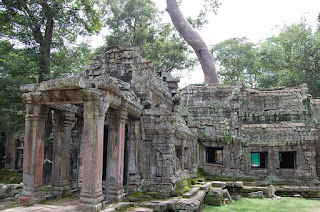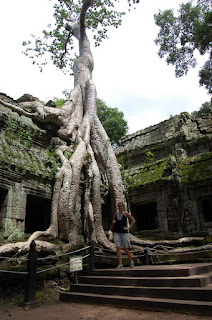The "wats" or temples were all built around the 10th and 11th centuries by the god-kings of the ancient Khmer civilization. They all served as temples (except for the 'hospital'), but they were also either tombs for the king that commissioned it, or were built as tributes to, for example, the king's mother. Most also have large moats or even huge reserviors around them, which were used for irrigation purposes for the surrounding countryside in the dry season. Call it compensation for having to send family members to work on temple construction.
The moat below surrounds Angkor Wat. It's huge!
The moat below surrounds Angkor Wat. It's huge!

You approach Angkor Wat by a large causeway that crosses the moat. It's a very impressive walk.
A favorite of locals looking for luck, this Buddha statue is an amalgamation of both Hinduism and Buddhism, with its Buddha's head but the many arms of a Hindu god.

Various temple photos below. None of the temples used cement or anything else to hold the towers together. Instead, they used stone-locking methods that have lasted for a thousand years!
Bayon was Karen's favorite temple, famous for the Buddha faces staring down at you everywhere. The misty morning added to the quiet and mystique of this place.
My favorite temple was this one, fighting a battle against Mother Nature and clearly losing.
Check out the tree at the center of the photo below -- it is growing on the roof!









No comments:
Post a Comment